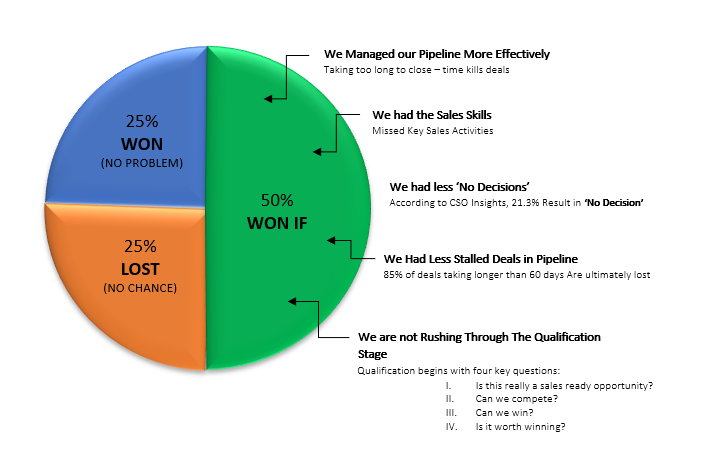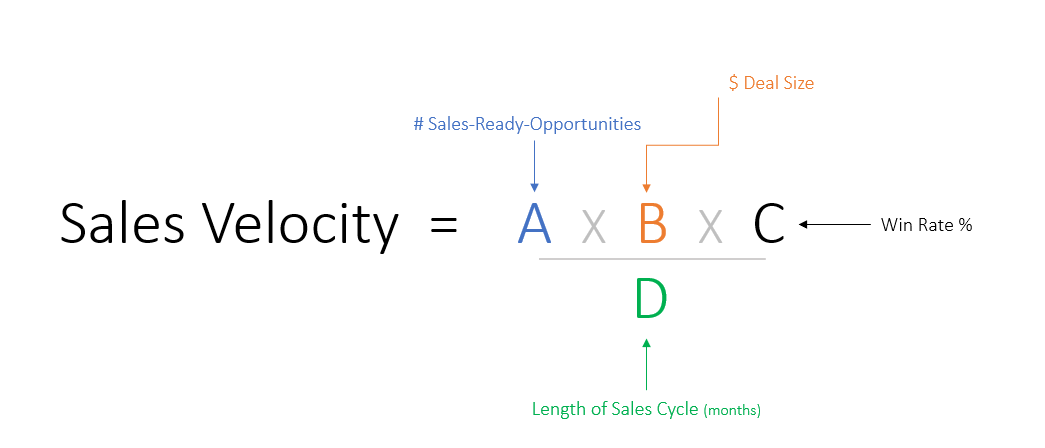
When prospecting, you may be ‘actively working’ referrals from your center of influence, marketing qualified lead lists, opportunities with existing customers, or other self-sourced opportunities. Some of these prospects result in a sales-ready-opportunity (when an opportunity has been qualified and is ready to share financials). According to our research 2 about 25% of sales-ready-opportunities will be won (no problem) and about 25% will be lost (they have no chance) but 50% are at play and could be won if . . .

Sales performance findings
According to our research2 less than 22% of salespeople consider time a key performance indicator (KPI) however, more than 25% of sales-ready-opportunities are lost because the sales cycle is too long and, according to CSO Insights, 21.3% result in no decision. Additionally, at least 60% of salespeople miss their sales goals – 60% of those underperformers are not effective prospectors and don’t find enough sales-ready-opportunities.
The following industry findings3 support our research:
- Only 17% of salespeople can get a second meeting with a prospect who has an identified sales-ready need.
- When prospecting, and without help, only 52% of salespeople can access key players and decision-makers.
- The win rate of an average salesperson is less than 47%, and the win rate for a high performer1 is over 70%.
How many prospects should you be actively working?
The above data provoke the most-asked question in sales: “How many prospects do I need to be ‘actively working’ to achieve my annual sales goals?”
You can find the answer with the following two-step process:
Step 1 Determine how many sales-ready opportunities are needed to achieve your goal.
Let’s assume you have:
- a sales velocity/goal of $12 million (about $1 million per month)
- a 50% win rate
- a $1 million average deal size
- 45-day (1.5 months) sales cycle

In this scenario, you need to have at least three new Sales-Ready Opportunities (SRO) per month.
Step 2: Determine how many prospects you will need to be ‘actively working’ 4 to achieve your annual sales goal.
Your prospect conversion ratio is a function of your prospecting skills and the source of your prospects. Your conversion ratio for existing customers is going to be the highest (greater than 20%), marketing qualified leads will not be higher than 10%, and cold calls will be less than 2%.

Assuming you need 3 sales-ready-opportunities per month, and you have a 15% conversion ratio, you will need to be ‘actively working’ 20 prospects every month.
How to find or create more high-quality prospects and increase your prospect conversion ratio
Performance Insights has partnered with the industry-leading sales training company St. Meyer & Hubbard to build a program for Act! Premium users to answer this question. The program is called Managing Breakthrough Results SM and it integrates sales training with visually compelling sales reports and analytics – and it all works the way you already work in Act!.
Training is virtual or onsite and (optionally) comes with a one-day workshop to tailor the reports and analytics to the way you sell and use Act! You will acquire the skills to find and close more sales-ready opportunities.
1 High Performers are those achieving at least 130% of their annual sales goals
2 What Winners Do Different SM research by Performance Insights
3 CSO Insights, Gartner, and Forrester
4 Actively calling, emailing, and having purpose-driven conversations
About the author

Ron Buck is the Chairman & CEO of Performance Insights – an industry-leading software company serving the financial services industry. Ron is a recognized industry leader and has taken two companies public prior to Performance Insights.





